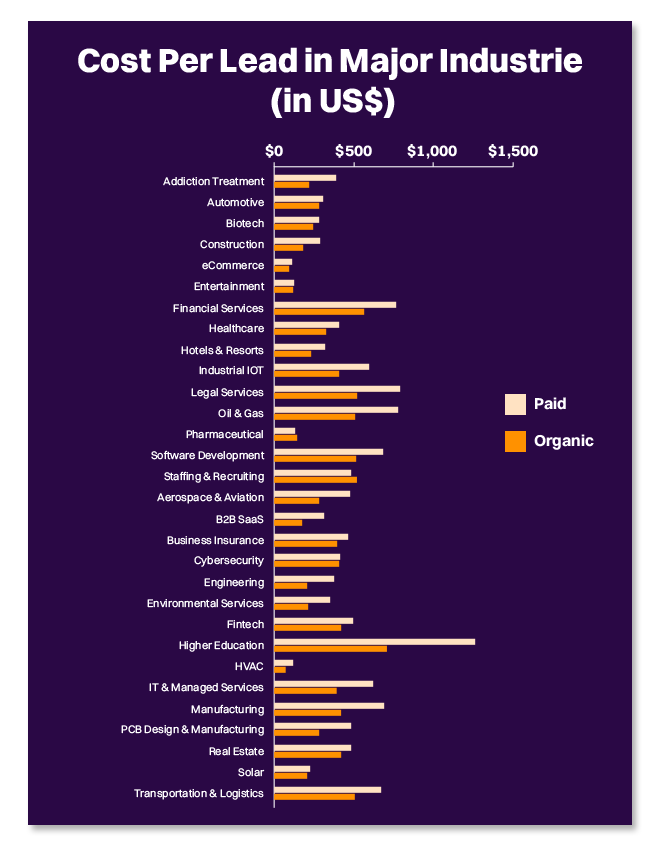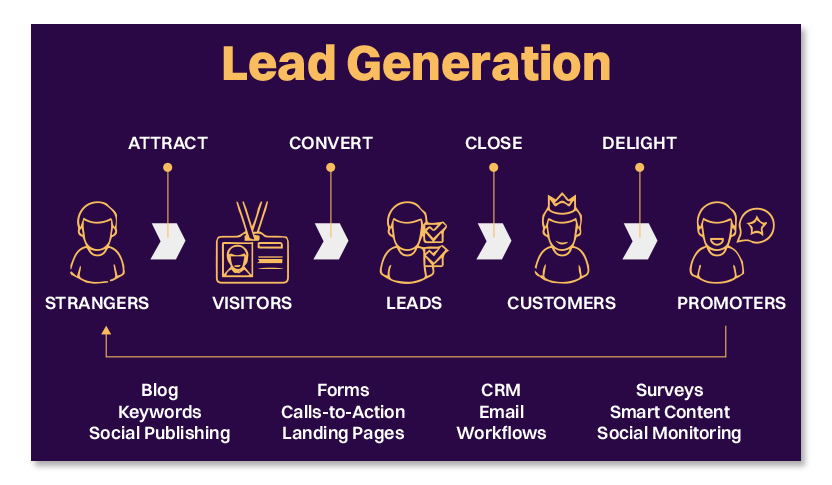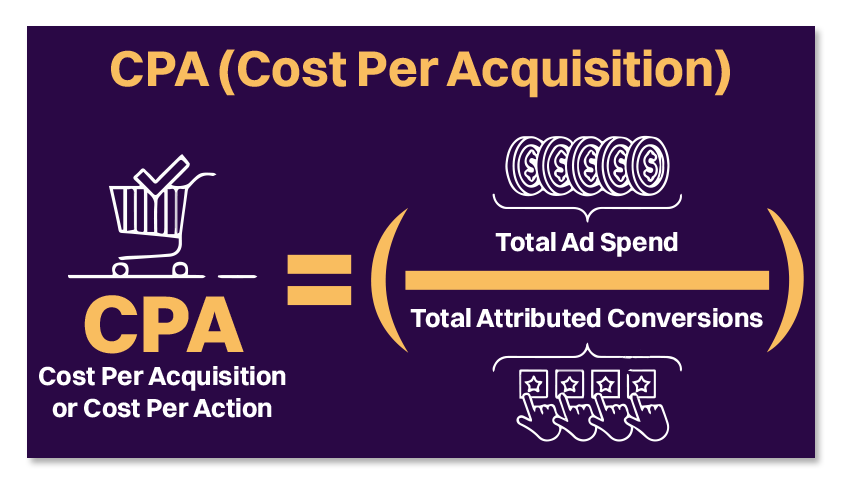
What Is Cost Per Lead and Why It Matters for Your Business
How much are you willing to pay for a lead? Do you know how to measure and optimize your Cost Per Lead (CPL)? If not, you might miss out on a crucial metric to boost your marketing ROI.
The CPL pricing model works because advertisers pay a certain amount for each lead they obtain.
However, not all leads are created equal. Some leads are more qualified, engaged, and likely to convert than others. Therefore, it is essential to understand the concept of cost per lead and how it affects your marketing strategy and performance.
Businesses with a mature lead generation process experience a 133% increase in revenue
Impressive, right?
So let’s explore CPL, why it matters, and how to calculate and optimize it for your business. By the end of this article, you will have a clear idea of how to use cost per lead to improve your marketing ROI and grow your business.
Let's get started!
How To Calculate Cost Per Lead

/
How To Reduce Your CPL
Reducing your CPL is an ongoing process that requires continuous testing, monitoring, and optimization. You can establish a more cost-effective lead-generating process by implementing and customizing these methods as per your business needs.
Here are the top 7 points on reducing your CPL:
- Optimize Targeting: Reach the right audience interested in your product/service.
- Improve Ad Quality: Create compelling, attention-grabbing ads.
- Test Different Ad Formats: Find cost-effective channels that work best.
- Enhance Landing Page: Align with ad messaging, and simplify the conversion process.
- Implement CRO Techniques: Optimize your website and conversion funnel by Conversion Rate Optimization (CRO).
- Leverage Remarketing: Stay engaged with potential leads.
- Analyze and Optimize Regularly: Monitor campaigns, and make data-driven adjustments.
Benefits of Reduced CPL
Knowing how to calculate your CPL is one thing. However, reducing it is another aspect that you should be more concerned with. So, reducing your cost per lead can result in:
- Allocating Your Budget More Efficiently
- Increasing Profitability
- Creating Room For Scalability And Growth
- Giving You a Competitive Advantage
- Giving You Long-Term Sustainability
The Top 8 Factors that Impact CPL
To understand better how CPL works, we are going to show you the top 8 factors that show you how much you need to charge for a lead:
1. Target Audience
First off, identifying your target audience accurately is like hitting the bullseye of your marketing efforts. When you clearly understand your ideal B2B customers, you can tailor your marketing strategies to them, optimizing your CPL.
Here's why your target audience matters regarding CPL:
- Precision in Targeting: Defining your target audience thoroughly helps narrow your marketing efforts. Also, minimizing wasted ad spend on irrelevant leads allows you to focus on attracting high-quality prospects with a higher likelihood of conversion.
- Customized Messaging and Offers: Knowing your target audience helps you create tailored messaging that addresses their pain points and showcases the value of your B2B solution, increasing the chances of generating quality leads. Customized messaging improves engagement.
- Efficient Campaign Optimization: A well-defined target audience enables you to closely monitor and optimize marketing campaigns. Thus, you can make data-driven adjustments to refine targeting and messaging. This continual improvement helps drive down your CPL.
Below is an example of CPL as per company size:
| Target Audience Segment | Marketing Budget | Number of Leads | Qualified Leads | CPL | Qualified CPL |
| Segment A: Small Businesses | $50,000 | 500 | 100 | $100 | $500 |
| Segment B: Mid-sized Businesses | $50,000 | 300 | 150 | $166.67 | $333.33 |
| Segment C: Enterprise-level Businesses | $50,000 | 200 | 100 | $250 | $500 |
In this example, the B2B marketing campaign targets three different segments: Small, Mid-sized, and Enterprise. Each piece has a specific marketing budget, and the number of leads generated varies based on the targeting efforts.
As we analyze the data, we see that the CPL goes for each segment based on the marketing budget and the number of leads generated. However, when considering the qualified leads within each target audience segment, the qualified CPL becomes more relevant as it reflects the cost per lead for leads that are more likely to convert.
2. Audience Segmentation
Audience segmentation confidently impacts CPL. Precisely targeting specific segments allows tailored messaging, optimized ad spending, and higher-quality lead conversions, resulting in reduced costs per lead. A well-defined segmentation strategy empowers you to allocate resources for better ROI and lower CPL confidently.
Top 4 tips on how to deal with audience segmentation:
- Conduct thorough market research to identify your ideal customer profile.
- Refine your targeting by leveraging customer data and insights.
- Segment your audience based on relevant demographics, interests, or behaviors.
- Personalize your messaging and ad campaigns to resonate with specific segments.
3. Products and Services
The price of your B2B products and services directly impacts your CPL. Higher-priced offerings come with a longer sales cycle, requiring additional resources for nurturing and building trust. It leads to a higher cost per lead compared to lower-priced offerings.
However, it's important to balance lead quality and cost-effectiveness. Higher-priced services frequently provide leads with better conversion and revenue prospects. It's critical to check that your price reflects the value you offer and fulfills the expectations of your target market.
Example: Suppose your company offers a comprehensive software solution priced at $50,000 annually. The typical sales cycle lasts around six months for this high-value software. With a $100,000 yearly marketing budget, your firm utilizes various marketing techniques throughout this period, such as paid advertising, content marketing, and industry events.
Let's say your marketing efforts result in 100 leads being generated over the course of a year. Out of these leads, 30% (30 leads) are considered qualified and have the potential to convert into paying customers.
Calculating the Cost Per Lead (CPL) for this campaign:
CPL = Marketing Budget / Number of Leads
CPL = $100,000 / 100
CPL = $1,000
However, when considering the qualified leads only, the calculation changes:
Qualified CPL = Marketing Budget / Number of Qualified Leads
Qualified CPL = $100,000 / 30
Qualified CPL = $3,333
While the overall CPL may seem high at $1,000, it's important to note that the qualified CPL is $3,333. It reflects the investment required to nurture and convert leads into customers for a higher-priced software solution. The potential revenue from converting even a few of these qualified leads into customers can be significant, making the investment worthwhile.
4. The Level of Competition In Your Industry
High competition among businesses vying for the attention of the same target audience can drive up the cost of acquiring leads. However, you can navigate this competitive landscape and optimize your CPL with the right strategies and approach.
Here's an example to illustrate this point:
Consider owning a B2B software company that provides project management services. In your industry, several other companies are offering similar software with comparable features and pricing. Because of the intense competition, firms in your target market have many possibilities.
As a result, advertising platforms like search engines or social media platforms become saturated with ads from various software providers. This increased competition for ad space can drive up the cost of impressions, clicks, and lead generation. Consequently, your CPL may be higher due to the intense competition for the attention of potential customers.
To optimize your CPL, consider the following strategies:
- Target Niche Markets: Focus on specific industry segments where you can differentiate yourself. Tailor your marketing efforts to narrow your audience and reduce CPL.
- Highlight Unique Value: Emphasize the features, functionalities, or customer support that make your offering superior to competitors. Showcase your unique selling points to attract leads who value your distinct advantages and improve CPL.
- Refine Targeting: Continuously analyze audience data and feedback to understand pain points, preferences, and behavior patterns. Optimize targeting strategies to reduce wasted ad spend and generate higher-quality leads.
- Use Remarketing and Retargeting: Re-engage with interested website visitors through remarketing campaigns. Remind them of your value proposition, increasing conversion chances and potentially lowering CPL.
5. Marketing Strategy and Team Performance
Your marketing strategy and team performance are key factors determining your CPL in the B2B landscape. A well-defined strategy and a high-performing team enable efficient targeting, relevant messaging, optimized conversions, and effective campaign execution.
By aligning your strategy with your target audience and leveraging your team's skills, you can optimize your CPL and achieve successful marketing outcomes.
To optimize CPL in B2B marketing, focus on the critical factors:
- Strategy Alignment: Align your marketing strategy with the target audience and business objectives to attract qualified leads and reduce CPL.
- Efficient Lead Generation: Employ effective tactics like content marketing, SEO, social media ads, and email campaigns to engage the right prospects and maximize lead quality.
- Data-Driven Decisions: Analyze campaign results and key metrics to refine targeting, messaging, and optimization strategies, reducing CPL.
- Skill Development: Invest in ongoing training and development to enhance your marketing team's capabilities and drive better results, positively impacting CPL.
Example: For instance, let's say your team is responsible for outbound marketing campaigns, where they proactively reach out to potential clients through personalized emails and phone calls.
A high-performing team will excel in crafting compelling messages, conducting thorough research on prospects, and nurturing relationships to move leads further down the sales funnel. Their expertise and skills contribute to improved lead quality, higher conversion rates, and ultimately a lower CPL.
6. Geography
Why does the country where your target audience resides affect lead costs? Let's explore the reasons:
- Market Demand: The size and maturity of a country's market can greatly impact business opportunities. A larger and more mature market often translates to a higher demand for products or services, influencing lead costs.
- Industry Vertical: Different countries have varying saturation levels within specific industries. For instance, the real estate market can be more competitive in the United States than in Canada. This competition can impact the cost of generating leads within that industry.
- Advertising Costs: Ad spending varies across regions due to factors such as currency rates and economic conditions. Advertising costs are higher in countries with larger economies like the United States. Consequently, the cost of generating leads and the charges per lead will likely be higher in these regions.
- Data Availability: Laws and rules governing data privacy differ from one nation to another. Some regions may have stricter laws, making acquiring the necessary data for lead generation more challenging and expensive.
- Cultural Factors: Your target audience's language and communication styles can also influence lead costs. If your target audience resides in a location where the language and communication norms differ significantly from your own, additional resources like translators or cultural consultants may be required.
When determining the cost of leads for your business, conducting thorough research on these factors is crucial.
7. Method of Lead Generation
Different methods of lead generation exist, each with its own implementation cost, which directly impacts the overall cost of acquiring leads. It is advantageous to keep lead generation costs as low as possible to attract more clients and increase profitability.

One effective approach is to choose the method that provides the quickest and most direct path to your target audience.
For instance, if you specialize in generating leads for a company offering accounting software solutions, utilizing SEO and content marketing can be highly effective. By optimizing client company pages and creating valuable content, you can attract and engage your target audience.
Incorporating lead capture forms and personalized email marketing based on lead information obtained can further nurture prospects. Conversely, cold calling can be effective due to low cost and competition in the industry.
Opting for other methods that align better with your target audience's preferences and behaviors can yield more cost-effective results.
8. Ad Optimization and Testing:
Best practices for running your Ad:
- Craft compelling ad copy and visuals that clearly communicate your value proposition.
- A/B test different variations of your ads to identify the most effective ones.
- Continuously optimize your ads based on data-driven insights and performance metrics.
- Experiment with different ad platforms and placements to find the ones that deliver the best results.
Challenges for Calculating CPL
While working to reduce your cost per lead, it's essential to be mindful of the common challenges and mistakes that businesses often encounter when calculating CPL. Let’s explore those mistakes and learn how you can avoid them:
1. Inaccurate Lead Tracking:
- Implement robust tracking mechanisms to attribute leads to specific campaigns accurately.
- Use UTM parameters and CRM systems to track and monitor lead sources.
- Set up conversion tracking on your website to gain insights into lead generation.
2. Ineffective Landing Pages:
- Optimize your landing pages to align with ad messaging and facilitate conversions.
- Streamline the form-filling process and make your call-to-action prominent.
- Conduct A/B testing to optimize your landing page design and content.
- Continuously monitor and improve your landing pages based on user behavior and feedback.
Top 6 Indicators To Use For Cost Per Lead Performance
1. Revenue
When evaluating the success of your CPL, revenue plays a significant role because it directly relates to the financial impact of your lead generation efforts. While CPL measures the cost of acquiring a lead, revenue indicates the money generated from those leads.
Using revenue as a performance indicator alongside CPL helps determine your lead generation campaigns' return on investment (ROI). It allows you to go beyond just the cost aspect and focus on the ultimate goal: generating revenue and driving business growth.
Let's consider two campaigns with similar CPLs. Campaign A generates 100 leads at a CPL of $10, totaling $1,000 in marketing spend. Campaign B, on the other hand, generates 50 leads at a CPL of $20, also totaling $1,000 in marketing spend. At first glance, both campaigns appear to perform equally based on CPL. When revenue is considered, however, Campaign A generates $10,000, whereas Campaign B creates $15,000.
2. Lead Quality
CPL measures the cost you incur to acquire a lead, but it only tells you a little about the quality of those leads. Lead quality refers to the likelihood of a lead converting into a paying customer or taking a desired action. It's not just about the number of leads generated but also the relevance, engagement, and potential value they hold for your business.
3. CPL
CPL provides insights into the average cost you need to spend to acquire a single lead. It's a measure that reveals how effectively you're utilizing your assets to produce leads for your company.
By tracking CPL, you can assess the effectiveness of your marketing or sales campaigns. A lower CPL generally indicates that you're acquiring leads at a lower cost, which is often considered favorable. Your lead generation strategies are cost-effective and efficient.
4. Customer Lifetime Value (CLV)
CLV refers to a customer's total revenue over their entire relationship with your business. Instead of focusing solely on the initial transaction or acquisition, CLV considers each customer's long-term value and profitability.
When assessing CPL, considering CLV helps you understand the true impact of your lead generation efforts. It provides insights into the potential return on investment (ROI) that a lead can bring over their lifetime as a customer. This is important because acquiring a high-quality lead at a higher CPL may still be worthwhile if that lead has a high CLV.
Considering CLV helps you make informed decisions about resource allocation and campaign optimization. By focusing on acquiring leads with a higher potential for long-term value, you can maximize the profitability of your lead generation efforts. It allows you to prioritize quality over quantity and target leads more likely to become repeat customers or make significant purchases.
Or you can use this simple formula to calculate your B2B CLTV:
CLTV = (Average Annual Revenue per Customer) × (Average Customer Lifespan)
- To calculate the Average Annual Revenue per Customer, you can divide the total revenue generated from a customer over a specific period by the number of years they have been a customer.
- To determine the Average Customer Lifespan, calculate the average number of years a customer stays with your business.
5. Cost Per Acquisition (CPA)
CPA measures the average cost to acquire a new customer or secure a desired action, such as a purchase or subscription. It considers the expenses of converting your lead into a paying customer, providing a more comprehensive view of your marketing or sales campaign's performance.
When assessing CPL, considering CPA helps you understand the efficiency of your lead conversion process. While CPL focuses on the cost of acquiring leads, CPA considers the ultimate goal of converting those leads into valuable customers.
However, it's essential to interpret CPA in the context of your business goals and industry benchmarks. The ideal CPA can vary depending on factors such as your profit margins, customer lifetime value, and competitive landscape.

6. Channel Performance
Channel performance refers to evaluating different marketing channels or platforms through which you acquire leads. It helps you understand how each channel contributes to lead generation, allowing you to allocate resources effectively and optimize your CPL.
By analyzing channel performance alongside CPL, you can identify the most effective channels for acquiring high-quality leads at an optimal cost.
Let's say you use SEO, social media marketing, email marketing, and other channels to carry out campaigns. By tracking the CPL for each channel, you can determine which channels are generating leads at a lower cost. If you find that email marketing has a lower CPL than social media advertising and SEO, it indicates that email marketing is a more efficient channel for lead acquisition.
Various marketing channels:
- Cold Calling
- Cold Email Marketing
- Content Syndication
For more information on utilizing these marketing channels, please check out Revnews’ blog. We have all the information you need on how to properly optimize, utilize and handle every obstacle you will encounter when dealing with these topics.
Final Thoughts
Understanding and effectively managing the cost per lead is crucial for businesses, as it directly impacts marketing efforts, profitability, and scalability. You can optimize your CPL and achieve better results by implementing strategies such as targeting and segmentation, ad optimization and testing, and avoiding common pitfalls.




